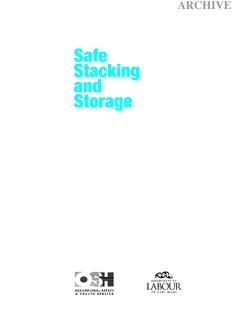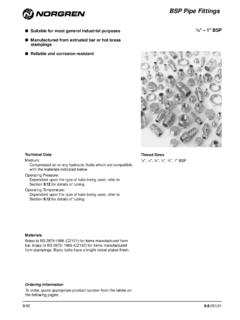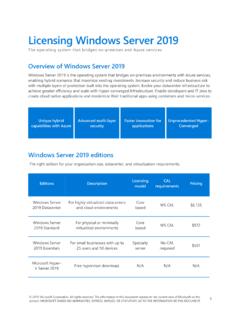Transcription of Excitons – Types, Energy Transfer - MIT OpenCourseWare
1 1 Excitons Excitons Types, Energy TransferTypes, Energy Transfer @ MITF ebruary 27, 2003 Organic Optoelectronics - Lecture 7 Wannier exciton Charge- Transfer exciton Frenkel exciton Exciton Diffusion Exciton Energy Transfer (F rster, Dexter)Handout (for Recitation Discusssion) Yang and Swager, J. Am. Chem. Soc. 120, 5321 (1998)Q. Zhou and Swager, J. Am. Chem. Soc. 117, 12593 (1995)2 Caption from IUPAC Compendium of Chemical Terminologycompiled by Alan D. McNaught and Andrew Wilkinson (Royal Society of Chemistry, Cambridge, UK).ExcitonIn some applications it is useful to consider electronic excitation as if a quasi-principle, capable of migrating, were involved.
2 This is termed as exciton. In organic materials two models are used: the band or wave model (low temperature, high crystalline order) and the hopping model (higher temperature, low crystalline order or amorphous state). Energy Transfer in the hopping limit is identical with Energy PICTUREGROUND STATE FRENKEL EXCITONSEMICONDUCTOR PICTUREGROUND STATE WANNIER EXCITONCONDUCTIONBANDVALENCEBANDS1S0 Wannier exciton(typical of inorganicsemiconductors)Frenkel exciton(typical of organicmaterials)binding Energy ~10meVradius ~100 binding Energy ~1eVradius ~10 treat Excitons as chargelessparticlescapable of diffusion,also view them as excited states of the moleculeCharge Transfer (CT) Exciton(typical of organicmaterials) Excitons (bound electron-hole pairs)
3 Electronic Processes in Organic Crystals and Polymersby M. Pope and Swenberg4 Wannier-Mott ExcitonsColumbic interaction between the hole and the electron is given byEEX= -e2/ rThe exciton Energy is then E = EION EEX/n2, n = 1,2, ..EION Energy required to ionize the moleculen exciton Energy levelEEX= eV /m reduced mass = memh/ (me+mh)Adapted from Electronic Processes in Organic Crystals and Polymersby M. Pope and Swenbergn = ----------5An Example of Wannier-Mott Excitonsexciton progression fits the expression [cm-1] = 17,508 800/n2corresponding to = and = 10 The absorption spectrum of Cu2O at 77 K, showing the exciton lines corresponding to several values of the quantum number n.
4 (From Baumeister 1961). Quoted from Figure Electronic Processes in Organic Crystals and Polymersby M. Pope and Swenberg6 Charge Transfer ExcitonsThe lowest CT exciton state in the abplane of an anthracene crystal with two inequivalent molecules per unit cell; the plus and minus signs refer to the center of gravity of charge distribution. The Frenkel exciton obtains when both (+)and ( )occupy essentially the same molecular site. 7 Crystalline Organic FilmsPTCDAPTCDAxyz substrateGOOD CARRIER MOBILITYIN THE stacking DIRECTION = cm2/Vs stacking direction = 10-5cm2/Vs in-plane directionCHARGED CARRIER MOBILITY INCREASES WITH INCREASED ORBITAL OVERLAPH ighest mobilities obtained onsingle crystal pentacene = 10 5cm2/Vs at 10 Ktetracene = 104cm2/Vs at 10K(Sch n, et al.)
5 ,Science 2000).8 PTCDA monolayer on HOPG(STM scan)Organic Semiconducting MaterialsVan der Waals-BONDEDORGANIC CRYSTALS (and amorphous films)HOMO of3,4,9,10- perylene tetracarboxylic dianhydride9 PTCDA Solution(~ 2 M in DMSO) [eV]AbsorptionFluorescenceS1[0-3]S1[0-2] S1[0-1]S1[0-0]CT [0-ST]CT [0-F]S1[0-1]S1[0-0]10 PTCDA Thin [ST-1]CT [ST-2]CT [ST-3]S1[0-3]S1[0-2]S1[0-1]CT [0-ST]S1[0-0]CT [0-F] Energy [eV]11 PTCDA Solution(~ 2 M in DMSO) [eV]AbsorptionFluorescencePTCDA Thin eV12 Solution MAbsorption [ ] Energy [eV]PTCDA in DMSOAGGREGATEAGGREGATES tateStateAGGREGATE STATE ABSORPTION increaseswith PTCDA solution concentration = = = = [0-0]: eVS1[0-2]: eVCT [0-ST]: eVS1[0-1].
6 EVRelative Oscillator StrengthPTCDA Concentration in DMSO [ M] [k] = MAbsorption [ ] Energy [eV]Absorption of Vibronic Transitions Change with Solution M2 MFluorescence [ ] Energy [eV]01201234I [k] FluorescenceIntensity [ ]Solution Concentration[k] [ M]Solution Solution Concentration [k]Monomer and Aggregate Concentration in SolutionAGGREGATE[ka] [k] [km] [k] [ M]MonomerConcentration[km]AggregateConce ntration[ka][ M]rate of riser = and Aggregate concentrationsare derived from integrated solutionfluorescence efficiency by assuming thatthe eV solution fluorescence is dueto monomers and that the most dilutesolution primarily contains eVMONOMERTRANSITIONSTHIN eVS0 MONOMERTRANSITIONSTHIN FILMTRANSITIONSPTCDA Electron Energy StructureAbsorptionLuminescence17 PTCDA Solution(~ 2 M in DMSO) [eV]AbsorptionFluorescencePTCDA Thin eV18 Solution and Thin Film M MThin Film(E + eV)
7 Fluorescence [ ] Energy [eV]0204060101102103 Solution = nsThin Film = nsNormalized CountsTime [ns]FLUORESCENCE LIFETIME* Thin film fluorescence is red-shifted by eV from solution fluorescence* Minimal fluorescence broadening due to aggregation* Fluorescence lifetime is longer in thin films19 Thin Film Excitation nm PTCDAThin FilmIntegrated Fluorescence [ ]Excitation Energy [eV]CT [0-ST]CT [0-F]S1[0-0]S1[0-1]S1[0-2]S1[0-3]* Fluorescence Energy and shape is not affected by the change in excitation Energy * Fluorescence efficiency increases when exciting directly into CT stateS1S0 CTT1S1S0 CTT1201010010000102030mh, = momh, = momh, = mo E1s[meV]d[ ] E LUMO E HOMOdPTCDANTCDAPTCDAPTCDANTCDAE xciton Quantum Confinement in Multi Quantum WellsSo and Forrest, Phys.
8 Rev. , 2649 (1991).Shen and Forrest, Phys. Rev. B55, 10578 (1997).Exciton radius = 13 21-3-2-101 Bandwidth >> VPSEUDOD elocalized CT ExcitonV [eV] rBandwidth << VPSEUDOL ocalized CT Exciton r-3-2-101V [eV](a)(b)22T1S1S0 FLUORESCENCEPHOSPHORESCENCEENERGY TRANSFERF RSTER, DEXTERor RADIATIVEINTERNALCONVERSIONABSORPTION10 ps1-10 ns>100 nsEnergydensity of availableS and T states on surrounding molecules Electronic Processes in MoleculesJABLONSKI DIAGRAMINTERSYSTEMCROSSINGS: spin=0 (singlet) statesT: spin=1 (triplet) EL IntensityWavelength [nm]Alq3 PtOEP:Alq3 DCM2:Alq3 PtNNNNAlNO3 OCNNCNE ffect of Dopants on the Luminescence Spectrum24 Nonradiative Energy TransferHow does an exciton in the host Transfer to the dopant?
9 Energy Transfer processes:1. Radiative transfer2. F rster transfer3. Dexter transferhost moleculesdopant molecules(generate luminescence)













